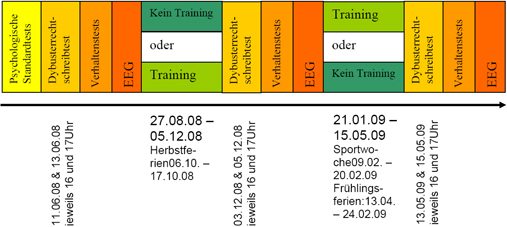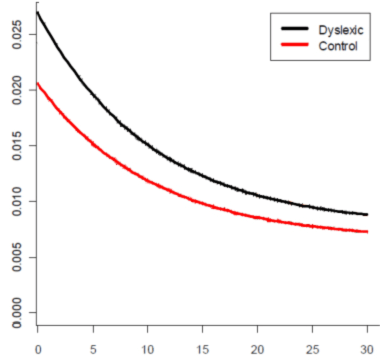|
Topics
Introduction
After the study in 2006, which provided evidence for the efficiency of Dybuster, the software has been enhanced and optimized at the department of computer science of the ETH Zürich. While the last study was conducted to objectify an increase in the writing performance, this study mainly focuses on investigating the additional transfer effects. On this page you will find information on the new study, the random sample, the course of the study and examinations.
The random sample
We are looking for dyslexic and non-dyslexic, native German speaking children at the age between nine and eleven. Again, the children will be split into four groups. In the first phase, one dyslexic and one non-dyslexic group will be training with Dybuster, while the other children will not be training. After the 3 month of training they will switch. The children, which haven't had the joy of Dybuster so far, will start to train and the others will suspend their training. For the scientific interpretation of the data it is important that four groups do not vary in terms of age, sex, education and IQ. Therefore, the exact division into the four groups will be done after the first series of tests.
The course of the study

The Training
The children of the training group work daily for about 15 - 20 minutes at home at their own computer for a period of 3 month. Once a week (Wednesday or Friday afternoon) they will performe their training under surveillance of psychologist and computer scientists at the ETH (map). However, they will not receive a therapeutical support, but will merely be advised of the functionality and learn aids of Dybuster.
The data collection
At the beginning of the study we will collect a standardized series of tests, which include reading and writing tests as well as an IQ-test. Using this data we will divide the children into the corresponding groups. To quantify the training performance and to show transfer effects on not trained words, we run a writing test of 100 words, of which 50 will be trained later during the Dybuster study. Furthermore, we would like to study transfer effects on other functions, language, memory and attention. Therefore, the children will pass another standardized psychological series of tests. Since we assume that the Dybuster training evokes neural changes, we will additionally run EEG (Elektroencephalograpie) measurements. EEG is an established, non invasive method to measure cortical activity. If, during the examination, an additional finding (like epilepsy typical potential in the EEG) would be discovered, we would inform the parents. All the cooperators of the study are subject to the patient confidentiality.
Results
The results measured with the Dybuster writing test replicated the results from the user study 2006. The training dyslexics e.g. improved again by about 35%.
In addition, the study showed that the children, both dyslexics and non-dyslexics, improved their memory of the phoneme-grapheme-correspondance signficantly:

Figure: x-axis: Training days (time). y-axis: Error probability of the p-g-matching.
The figure above shows the decrease of the probability that the children committed an error in the phoneme-grapheme-matching over the course of 30 training days. Because problems in establishing the p-g-correspondence are generally considered one of the main deficits in dyslexia, this finding explains why the writing measuered with the Dybuster writing test showed such significants improvements, too.
Publications
- Kast M., Baschera G.-M., Gross M., Meyer M and Jaencke L, Computer-based learning of spelling skills in children with and without dyslexia, Annals of Dyslexia, 2011 (Link)
>
back to top
|









